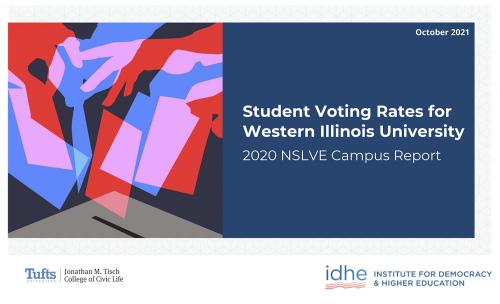Student Voting on WIU Campus Up in 2020
November 2, 2021
MACOMB, IL – Student voting at Western Illinois University increased 12 percent in last year's presidential election, moving from the 2016 rate of 45.3 percent, to 57.3 percent in 2020.
The data was compiled by the Institute for Democracy and Higher Education (IDHE), creators of the National Study of Learning, Voting and Engagement (NSLVE). IDHE is located at Tufts University's Tisch College of Civic Life.
"Voting improved at Western across racial and ethnic groups, as well as for most majors and fields of study reported," said WIU Political Science Chair Keith Boeckelman. "We are pleased at the increases in engagement between the last two presidential elections, and would like to see continued improvement so that campus voting at Western reflects national benchmarks."
Nationwide, the study's authors report record-breaking findings. On campuses across the United States, students built on the momentum swing of 2018, and voted at high rates in the 2020 election. Voter turnout increased to 66 percent in last year's presidential election, a 14 percentage point increase from the 52 percent turnout in 2016. These numbers outpace those of all Americans, which increased 6 percentage points, from 61 percent – 67 percent, according to the U.S. Census Bureau.
"That students, often younger and first-time voters, turned out at rates commensurate with the general public is nothing short of stunning," said IDHE Director Nancy Thomas. "We attribute this high level of participation to many factors, including student activism on issues such as racial injustice, global climate change and voter suppression, as well as increased efforts by educators to reach students and connect them to the issues and to voting resources."
NSLVE (pronounced n-solve) is the nation's largest study of college and university student voting.
Institutions must opt-in to the study, and, at this time, nearly 1,200 campuses of all types—community colleges, research universities, minority-serving and women's colleges, state universities, and private institutions—participate.
The dataset reflects all 50 states and the District of Columbia, and includes 49 of the nation's 50 flagship schools. IDHE uses de-identified student records to ensure privacy. The 2020 dataset is robust, with 8.8 million voting-eligible students, representing 1,051 colleges and universities.
Posted By: University Communications (U-Communications@wiu.edu)
Office of University Communications & Marketing


Connect with us: